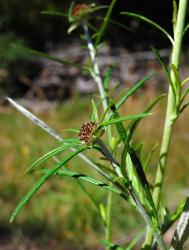- Taxon
- Gallery
- ≡ Gnaphalium sphaericum Willd., Enum. Pl. [Willdenow] 868 (1809)
- ≡ Euchiton sphaericus (Willd.) Anderb., Opera Bot. 104: 167 (1991) nom. illeg., non Euchiton sphaericus (Willd.) Holub 1974, nom. superfl.
- = Gnaphalium hemisphaericum Hornem. (1815)
- = Euchiton forsteri Cass., Dict. Sci. Nat. 56: 216 (1828)
- = Gnaphalium involucratum var. β ramosum DC., Prodr. [A. P. de Candolle] 6, 236 (1838)
- = Gnaphalium virgatum Banks & Sol. ex Hook.f., Bot. Antarct. Voy. II. (Fl. Nov.-Zel.) Part I, 139 (1853)
- = Leontopodium japonicum var. sandwicense H.Lév., Repert. Spec. Nov. Regni Veg. 10: 121 (1911)
- = Gnaphalium morii Hayata, Icon. Pl. Formosan. 58 (1919)
Annual, without stolons; stems 1-few, ascending to erect, simple or much- branched in lower 1/2, (1)–3–50 cm tall. Lvs all cauline at flowering, apetiolate, densely white-tomentose on lower surface, becoming sparsely tomentose to ± glabrous on upper, plane, usually spathulate to oblanceolate, sometimes elliptic or almost linear, cuneate, usually acute, rarely obtuse, mucronate, (6)–15–70–(100) × 2–10–(15) mm. Capitula c. 1 mm diam., numerous in dense globular terminal clusters, very rarely few axillary clusters below; longest subtending lvs c. 1–3× diam. of cluster. Involucral bracts narrow-oblong, gradually tapered to a blunt apex, 3.5–4.5 mm long; stereome green; lamina clear to pale or dark brown; gap and margins clear or tinged reddish purple. Achenes minutely papillate, 0.7–0.8 mm long.
[From: Webb et al. (1985) Flora of New Zealand. Volume 4 as Gnaphalium sphaericum Willd.]




